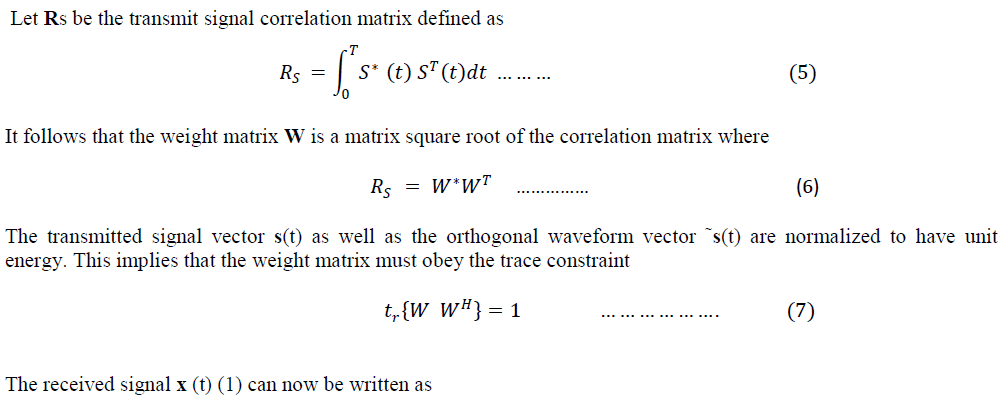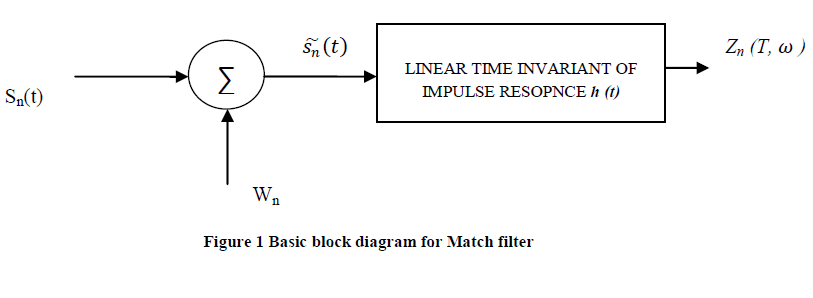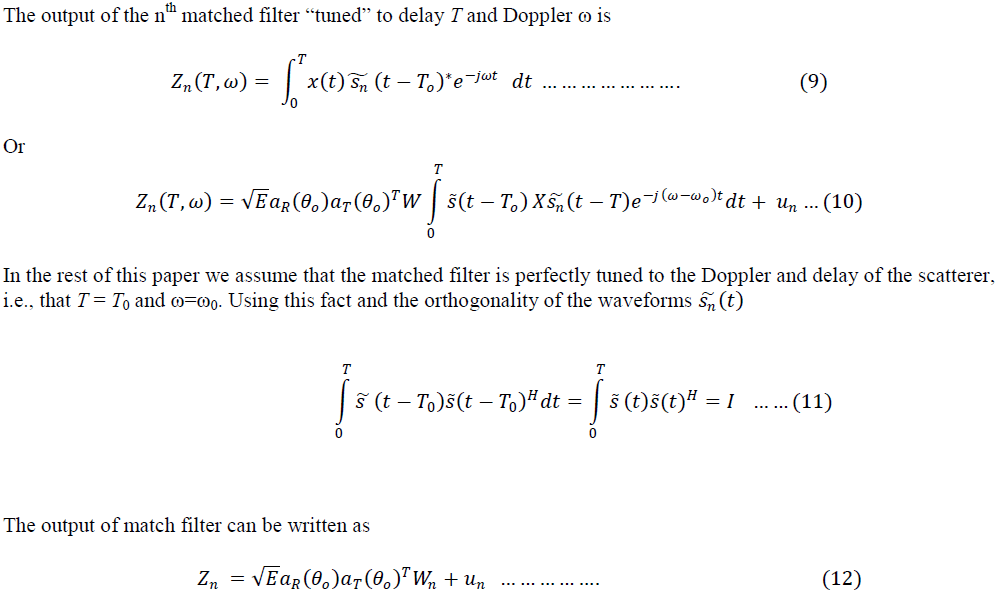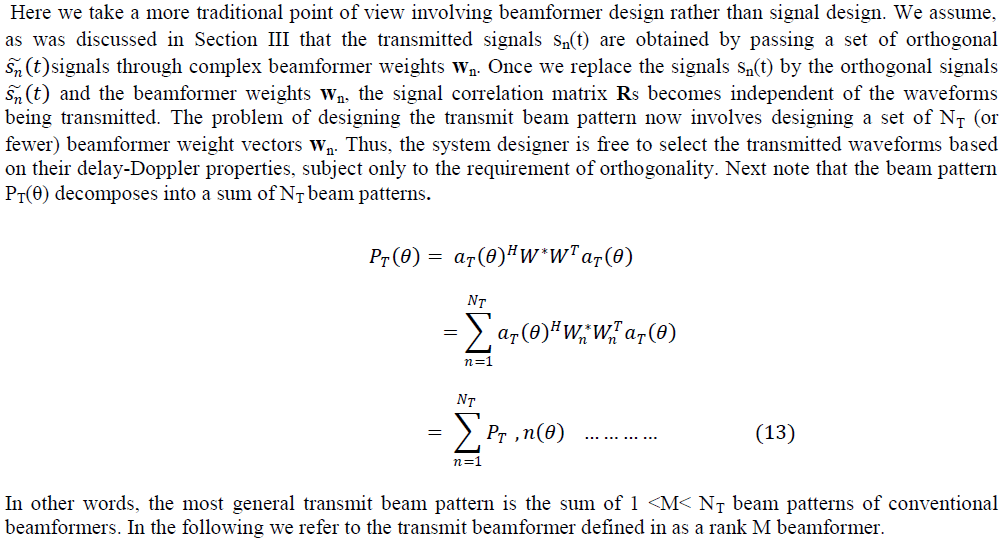ISSN ONLINE(2278-8875) PRINT (2320-3765)
ISSN ONLINE(2278-8875) PRINT (2320-3765)
Nilesh A.Bhavsar1, A. J. Vyavahare2
|
| Related article at Pubmed, Scholar Google |
Visit for more related articles at International Journal of Advanced Research in Electrical, Electronics and Instrumentation Engineering
This Paper describe the method of transmits beamforming design for MIMO radar. Transmit beamforming in MIMO radar based on the design of multiple correlated waveforms have been proposed.In this paper we present a different approach based on a reformulation of the problem which separates in a natural way the spatial and temporal parts of the design. This separation provides clearer insight into the transmit beamformer design and reveals the close connections to previous work on beam pattern synthesis and multi-rank beamformers. It also enables the application of well-known methods to the MIMO transmit beamformer design
Keywords |
| Signal model, Match filter design, Transmits multi-rank beamformer, Beamforming design. |
INTRODUCTION |
| Beamforming is a marriage between the antenna technology and digital technology.This is achieved by combining elements in a phased array in such a way that signals at particular angles experience constructive interference while others experience destructive interference In recent years there has been growing interest in a new class of radar systems employing multiple transmit antennas fed by different waveforms. In this paper we present a different approach based on a reformulation of the problem which separates in a natural way the spatial and temporal parts of the design. This separation provides clearer insight into the transmit beamformer design and reveals the close connections to previous work on beam pattern synthesis and multi-rank beamformers. It also enables the application of well-known methods to the MIMO transmit beamformer design. |
| The structure of the paper is as follows. In Section II problem formulation, section III we describe the Signal model, section IV Match filter design, Section V multi-rank beamforming, section VI examples of muti-rank designing and section VI contains brief conclusions. |
PROBLEM FORMULATION |
| Most of the work on MIMO radar considers using a set of uncorrelated transmits waveforms. However, using correlated waveforms has also been studied, especially in the context of transmit beamforming.The recent work on transmit beamforming for MIMO radar focuses on the design of the correlation matrix of the signals at the inputs of the array elements. This formulation of the problem couples the spatial (beamformer) and temporal (waveform) parts of the problem, significantly complicating the design.It leads to a solution requiring numerical optimization of a specified cost function which provides little insight into the problem. |
SIGNAL MODEL |
| Consider MIMO radar employing NT antennas at the transmitter and NR antennas at the receiver. We assume that the array aperture is sufficiently small so that the radar return from a given scatterer is fully correlated across the array. |
| To simplify the presentation we assume that the two arrays are collocated. The arrays are characterized by the array manifolds: aR(θ) for the receive array and aT(θ) for the transmit array, where θ is the direction relative to the array. We assume that the arrays and all the scatterers are in the same 2-D plane. The extension to the 3-D case is straightforward and all of the following results hold for that case as well. The baseband representation of the radar returns from a single scatterer at direction θ0 and delay T0relative to the radar is given by |
 |
| where x(t) is the NR ×1 vector of the receive array outputs at time t, s(t) is a NT × 1 vector of the transmitted signals at the different transmit antennas, h0 is the amplitude of the scatterer, and ω0 is the Doppler shift associated with it. The transmitted signal vector s (t) is normalized to have unit total energy, and the scale factor E represents the total transmit energy. Consider next the case where the transmitted signal s(t) is generated as a linear combination of a set of orthogonal signals ˜s(t), i.e., |
 |
 |
| In other words, each of the orthogonal signals is fed to the antennas through a beamformer wn. This is sometimes referred to as beamspace MIMO to distinguish it from element space MIMO where the signals ˜s(t) are fed directly to the antenna elements. |
 |
MATCH FILTER DESIGN |
| The received signal vector is assumed to be processed by a bank of matched filters, each matched to one of the waveforms . |
 |
 |
| It should be emphasized that the result above holds only when the matched filter is perfectly tuned to the Doppler and delay of the scatterer in which case the signals all have the same Doppler and delay shifts. Orthogonality is, of course, lost under general delay and Doppler shifts. We note also that the results do not change significantly when the transmitted signals are not perfectly orthogonal in which case (11) holds only approximately, as long as the cross correlation is smaller than the effect of the measurement noise. |
MULTI-RANK BEAMFORMER |
 |
TRANSMIT BEAMFORMER DESIGN |
| The design of a multi-rank transmits beamformer for MIMO radar depends on the radar mode of operation, power constraints, clutter characteristics, and so on. In this section we consider transmit beamforming for use during search and tracking. |
A. TRACKING A SINGLE TARGET |
 |
B.TRACKING A SINGLE TARGET |
| In Multiple Beamformer where it is desired to track multiple targets at known directions θ1…….. θK. This can be accomplished by a rank-K beamformer, where each component beamformer is designed as before, using a steering vector pointing at one of the targets. The non-windowed (or rectangular windowed) beamformer for the kth target is given by |
 |
| Where the factor of 1/ k reflects the fact that transmit power is equally divided among the targets. |
C.SEARCH MODE |
| When the radar is operating in search mode the target directions are unknown. In this case the best strategy is to illuminate uniformly the angular sector of interest. This can be accomplished by generating a “fan” of beams jointly covering the sector of interest. In phased-array radar these beams will be scanned. A MIMO radar can transmit on all beams simultaneously using a set of orthogonal waveforms. In other words, we use a multi-rank beamformer, where the rank equals the number of beams needed to cover the sector of interest. |
CONCLUSION |
| In this paper we presented a design approach to transmit beamforming for MIMO Radar based on the design of a multi-rank beamformer. The particular method presented here is based on designing rank-1 beamformers which are the components of the multi-rank beamformer. It was shown that both in tracking mode and in search mode the design of the rank-1 component beamformers is preferable to designing the composite multi-rank beamformer when the spatial response of the entire radar system (transmitter and receiver) is considered and designing of match filter to have maximized the SNR at the detector. Finally Because of the relative simplicity in design and transparency of the approach described in this paper we believe that it is useful as a reference to alternative transmit beamforming methods for MIMO radar application and remains an open area for further research. |
ACKNOWLEDGMENT |
| It is my pleasure to get this opportunity to thank my respected Guide Prof. Mrs. A.J.Vyavahare who imparted valuable knowledge specifically related to signal processing. |
References |
|